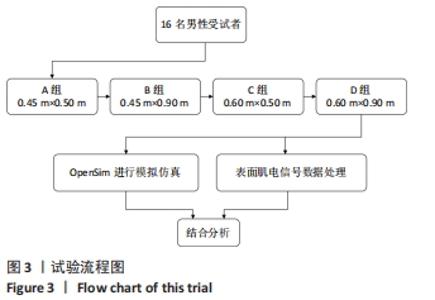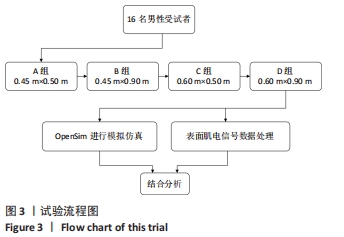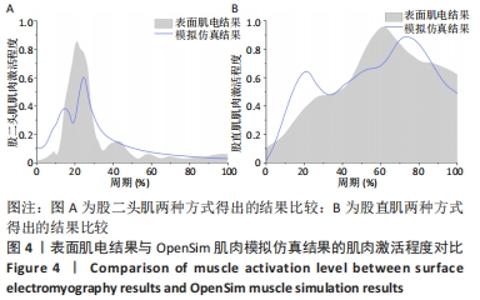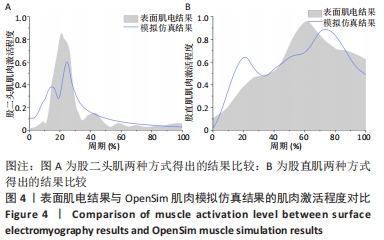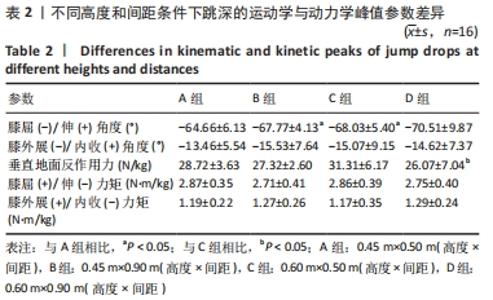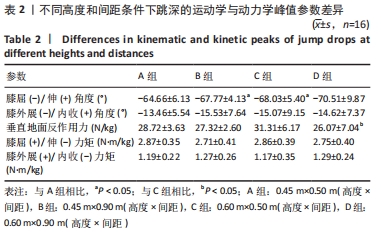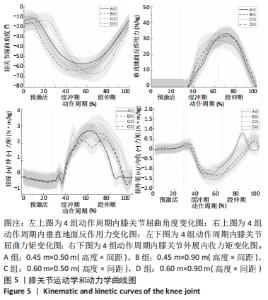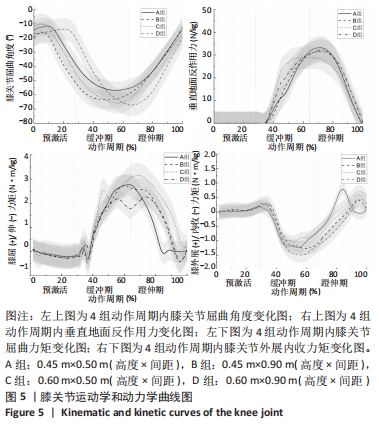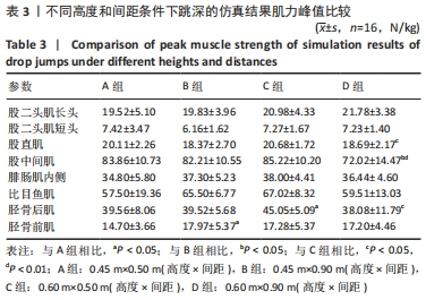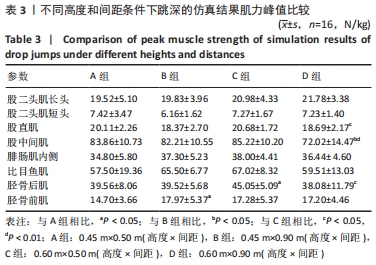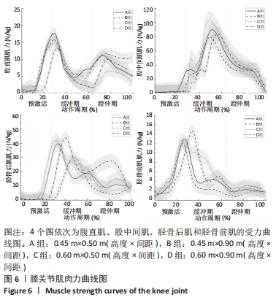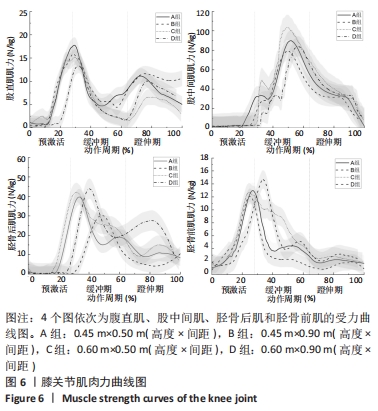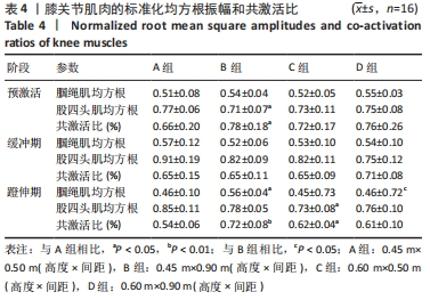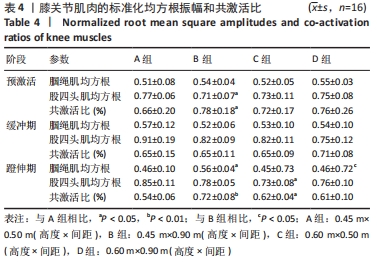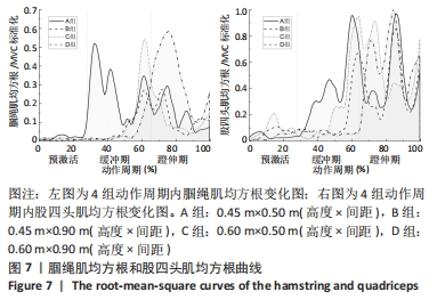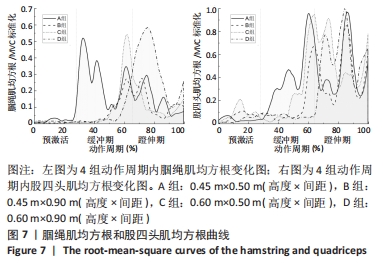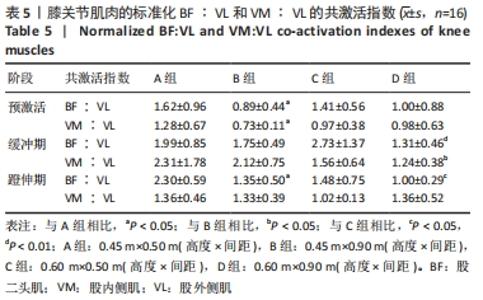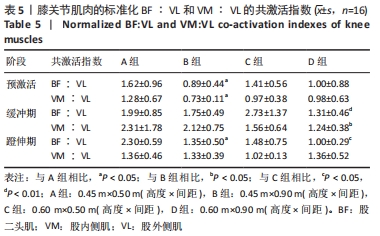Chinese Journal of Tissue Engineering Research ›› 2023, Vol. 27 ›› Issue (8): 1211-1218.doi: 10.12307/2023.084
Previous Articles Next Articles
Knee joint mechanics and activation characteristics of surrounding muscles during deep jumps at different heights and distances
Bi Gengchao, Zhang Yanlong, Li Qiuyue, Hu Longwei, Zhang Yu
- Mudanjiang Normal University, Mudanjiang 157011, Heilongjiang Province, China
-
Received:2022-01-25Accepted:2022-04-18Online:2023-03-18Published:2022-07-27 -
Contact:Zhang Yanlong, Master, Associate professor, Mudanjiang Normal University, Mudanjiang 157011, Heilongjiang Province, China -
About author:Bi Gengchao, Master candidate, Mudanjiang Normal University, Mudanjiang 157011, Heilongjiang Province, China -
Supported by:Heilongjiang Provincial Education Department Project, No. 1352MSYYB009 (to ZYL); 2021 Postgraduate Science and Technology Innovation Projects of Mudanjiang Normal University, No. kjcx2021-121mdjnu (to BGC) and kjcx2021-119mdjnu (to HLW)
CLC Number:
Cite this article
Bi Gengchao, Zhang Yanlong, Li Qiuyue, Hu Longwei, Zhang Yu. Knee joint mechanics and activation characteristics of surrounding muscles during deep jumps at different heights and distances[J]. Chinese Journal of Tissue Engineering Research, 2023, 27(8): 1211-1218.
share this article
Add to citation manager EndNote|Reference Manager|ProCite|BibTeX|RefWorks
| [1] COMYNS TM, BRADY CJ, MOLLOY J. Effect of attentional focus strategies on the biomechanical performance of the drop jump. J Strength Cond Res. 2019;33(3):626-632. [2] WALSH M, BOLING MC, MCGRATH M, et al. Lower extremity muscle activation and knee flexion during a jump-landing task. J Athl Train. 2012;47(4):406-413. [3] 戎科,钱竞光.运动生物力学仿真建模软件LifeMOD和OpenSim的建模比较[J].南京体育学院学报(自然科学版),2015,14(5):38-42. [4] 纪仲秋,李嘉慧,赵盼超,等.不同体质量幼儿纵跳过程中的生物力学特征[J].中国组织工程研究,2021,25(33):5281-5287. [5] KAR J, QUESADA PM. A Numerical Simulation Approach to Studying Anterior Cruciate Ligament Strains and Internal Forces Among Young Recreational Women Performing Valgus Inducing Stop-Jump Activities. Ann Biomed Eng. 2016;40(8):1679-1691. [6] NAVACCHIA A, UENO R, FORD KR, et al. EMG-informed musculoskeletal modeling to estimate realistic knee anterior shear force during drop vertical jump in female athletes. Ann Biomed Eng. 2019;47(12):2416-2430. [7] LESINSKI M, PRIESKE O, BEURSKENS R, et al. Effects of Drop-height and Surface Instability on Jump Performance and Knee Kinematics. Int J Sports Med. 2018;39(1):50-57. [8] MRDAKOVIC V, ILIC DB, JANKOVIC N, et al. Pre-activity modulation of lower extremity muscles within different types and heights of deep jump. J Sports Sci Med. 2008;7(2):269. [9] 井兰香,刘宇.不同高度跳深动力学及下肢肌肉预激活调节[J].体育科学,2012,32(11):64-69. [10] HELM M, FREYLER K, WALDVOGEL J, et al. Anticipation of drop height affects neuromuscular control and muscle‐tendon mechanics. Scand J Med Sci Sports. 2020;30(1):46-63. [11] WARD RE, FONG YAN A, ORISHIMO KF, et al. Comparison of lower limb stiffness between male and female dancers and athletes during drop jump landings. Scand J Med Sci Sports. 2019;29(1):71-81. [12] LLOYD RS, OLIVER JL, MYER GD, et al. Comparison of drop jump and tuck jump knee joint kinematics in elite male youth soccer players: implications for injury risk screening. J Sport Rehabil. 2019;29(6):760-765. [13] BROWN ME, MAYHEW JL, BOLEACH LW. Effect of plyometric training on vertical jump performance in high school basketball players. J Sports Med Phys Fitness. 1986;26(1):1-4. [14] 部义峰,李世明,熊安竹,等.不同高度、间距组合跳深练习对踏跳效果影响的实验研究[J].山东体育学院学报,2008,24(1):68-71. [15] HELM M, RITZMANN R,GOLLHOFER A, et al. Anticipation modulates neuromechanics of drop jumps in known or unknown ground stiffness. PLoS One. 2019;14(1):e0211276. [16] RILEY PO, FRANZ J, DICHARRY J, et al. Changes in hip joint muscle-tendon lengths with mode of locomotion. Gait Posture. 2010;31(2): 279-283. [17] MOON J, KIM H, LEE J, et al. Effect of wearing a knee brace or sleeve on the knee joint and anterior cruciate ligament force during drop jumps: A clinical intervention study. Knee. 2018;25(6):1009-1015. [18] MARIESWARAN M, SIKIDAR A, GOEL A, et al. An extended OpenSim knee model for analysis of strains of connective tissues. Ann Biomed Eng. 2018;17(1):1-13. [19] SASAKI K, NEPTUNE RR. Individual muscle contributions to the axial knee joint contact force during normal walking. J Biomech. 2010; 43(14):2780-2784. [20] 宋和胜,钱竞光.太极拳右“野马分鬃”正误动作中伸、屈膝肌肌力特征的计算机仿真分析[J].中国康复医学杂志,2020,35(5):566-574. [21] ELLENBERGER L, CASUTT S, FRÖHLICH S, et al. Thigh muscle activation patterns and dynamic knee valgus at peak ground reaction force during drop jump landings: Reliability, youth competitive alpine skiing-specific reference values and relation to knee overuse complaints. J Sci Med Sport. 2021;24(12):1230-1234. [22] 李萍,朱学强,李秀红,等.运动损伤预防训练对短跑运动员下肢生物力学和共激活特征的影响[J].中国体育科技,2021,57(11):30-37. [23] RUAN M, LI L. Approach run increases preactivation and eccentric phases muscle activity during drop jumps from different drop heights. J Electromyogr Kinesiol. 2010;20(5):932-938. [24] 贾谊,薛瑞婷,魏亮.人体快速起跳动作的下肢表面肌电信号特征研究[J].中国体育科技,2017,53(2):64-70. [25] 梅齐昌,相亮亮,孙冬,等.长距离跑后“足外翻”姿态增加膝关节内侧接触力:基于OpenSim肌骨建模及机器学习预测的研究[J].体育科学,2019,39(9):51-59. [26] WEINHANDL JT, SMITH JD, DUGAN EL. The effects of repetitive drop jumps on impact phase joint kinematics and kinetics. J Appl Biomech. 2011;27(2):108-115. [27] TSAI LC, KO YA, HAMMOND KE, et al. Increasing hip and knee flexion during a drop-jump task reduces tibiofemoral shear and compressive forces: implications for ACL injury prevention training. J Sports Sci. 2017;35(24):2405-2411. [28] KAPLAN JT, RAMSAY JW, CAMERON SE, et al. Association Between Knee Anatomic Metrics and Biomechanics for Male Soldiers Landing With Load. Am J Sports Med. 2020;48(6):1389-1397. [29] BLACKBURN JT, PADUA DA. Sagittal-plane trunk position, landing forces, and quadriceps electromyographic activity. J Athl Train. 2009;44(2): 174-179. [30] COWLING EJ, STEELE JR, MCNAIR PJ. Effect of verbal instructions on muscle activity and risk of injury to the anterior cruciate ligament during landing. Br J Sports Med. 2003;37(2):126-130. [31] BATES NA, NESBITT RJ, SHEARN JT, et al. Posterior Tibial Slope Angle Correlates With Peak Sagittal and Frontal Plane Knee Joint Loading During Robotic Simulations of Athletic Tasks. Am J Sports Med. 2016; 44(7):1762-1770. [32] STETTER BJ, KRAFFT FC, RINGHOF S, et al. A Machine Learning and Wearable Sensor Based Approach to Estimate External Knee Flexion and Adduction Moments During Various Locomotion Tasks. Front Bioeng Biotechnol. 2020;8:9. [33] ISHIDA T, KOSHINO Y, YAMANAKA M, et al. The effects of a subsequent jump on the knee abduction angle during the early landing phase. BMC Musculoskelet Disord. 2018;19(1):379. [34] FRIGO CA, WYSS C, BRUNNER R.The effects of the rectus femoris muscle on knee and foot kinematics during the swing phase of normal walking. Appl Sci. 2020;10(21):7881. [35] MOKHTARZADEH H, YEOW CH, GOH JCH, et al. Antagonist muscle co-contraction during a double-leg landing maneuver at two heights. Comput Methods Biomech Biomed Engin. 2017;20(13):1382-1393. [36] 袁鹏,许贻林,王丹,等.不同助跑速度条件下45°急停变向动作的膝和踝关节肌肉激活特征分析[J].体育科学,2018,38(8):49-58. [37] 傅维杰,刘宇,黄灵燕,等.不同着地方式下鞋缓冲特性对下肢肌肉活化及共激活的影响[J].中国运动医学杂志,2014,33(9):860-868. [38] EWING KA, FERNANDEZ JW, BEGG RK, et al. Prophylactic knee bracing alters lower-limb muscle forces during a double-leg drop landing. J Biomech. 2016;49(14):3347-3354. [39] HUBLEY-KOZEY CL, HILL NA, RUTHERFORD DJ, et al. Co-activation differences in lower limb muscles between asymptomatic controls and those with varying degrees of knee osteoarthritis during walking. Clin Biomech (Bristol, Avon). 2009;24(5):407-414. [40] KELLIS E, ARABATZI F, PAPADOPOULOS C. Muscle co-activation around the knee in drop jumping using the co-contraction index. J Electromyogr Kinesiol. 2003;13(3):229-238. [41] GRIBBLE PL, OSTRY DJ, SANGUINETI V, et al. Are complex control signals required for human arm movement? J Neurophysiol. 1998;79(3):1409-1424. [42] BAELLOW A, GLAVIANO NR, HERTEL J, et al. Lower Extremity Biomechanics During a Drop-Vertical Jump and Muscle Strength in Women With Patellofemoral Pain. J Athl Train. 2020;55(6):615-622. [43] AUGUSTSSON SR, TRANBERG R, ZÜGNER R, et al. Vertical drop jump landing depth influences knee kinematics in female recreational athletes. Phys Ther Sport. 2018;33:133-138. |
| [1] | Liu Jiaxin, Jia Peng, Men Yutao, Liu Lu, Wang Yeming, Ye Jinduo. Design and optimization of bone trabecular structure with triply periodic minimal surfaces [J]. Chinese Journal of Tissue Engineering Research, 2023, 27(7): 992-997. |
| [2] | You Guopeng, Wang Jianqing, Liu Fei, Yuan Qiang, Liu Haoyan, Wu Ying. Screening key technical indicators for speed climbing based on machine learning [J]. Chinese Journal of Tissue Engineering Research, 2023, 27(5): 738-744. |
| [3] | Xiong Bohan, Yu Yang, Lu Xiaojun, Wang Xu, Yang Tengyun, Zhang Yaozhang, Liao Xinyu, Zhou Xiaoxiang, He Lu, Li Yanlin. Research progress in promoting tendon to bone healing during anterior cruciate ligament reconstruction [J]. Chinese Journal of Tissue Engineering Research, 2023, 27(5): 779-786. |
| [4] | Wei Bo, Yao Qingqiang, Tang Cheng, Li Xuxiang, Xu Yan, Wang Liming. Advantage of medial pivot prosthesis in total knee arthroplasty via medial subvastus approach [J]. Chinese Journal of Tissue Engineering Research, 2023, 27(4): 552-557. |
| [5] | Li Shihao, Li Qi, Li Zhen, Zhang Yuanyuan, Liu Miaomiao, Ouyang Yi, Xu Weiguo. Plantar pressure and gait analysis in patients with anterior cruciate ligament injury and reconstruction [J]. Chinese Journal of Tissue Engineering Research, 2023, 27(4): 626-631. |
| [6] | Cheng Mingguang, Zhang Chaoyu, Zhuang Kangle, Ruan Peng, Zuo Yi, Zhou Zhengchun, Kong Xiang, Ge Jianjun, Cheng Guangcun. In vitro construction of Stanford type A aortic dissection 3D dynamic simulation diagram and individual tissue-engineered blood vessels [J]. Chinese Journal of Tissue Engineering Research, 2023, 27(3): 335-338. |
| [7] | Li Daen, Wu Yafei, Qiu Shang, Wang Gang, Gao Xuren, Chen Xiangyang. Factors associated with subscapularis injury and predictive efficacy based on three-dimensional CT reconstruction [J]. Chinese Journal of Tissue Engineering Research, 2023, 27(27): 4351-4356. |
| [8] | Li Panpan, Qing Haomiao, Ren Sixie, Zhang Yuanyuan. Correlation of medial and lateral posterior tibial slope and their differences with anterior cruciate ligament injury [J]. Chinese Journal of Tissue Engineering Research, 2023, 27(27): 4379-4384. |
| [9] | Liu Baijie, Zhou Honghai, He Xinyu, Qin Hongtu, Chen Longhao, Tian Junming, Lu Qingwang. Three-dimensional finite element method to analyze biomechanical characteristics of spinal manipulation [J]. Chinese Journal of Tissue Engineering Research, 2023, 27(27): 4385-4392. |
| [10] | Liu Chang, Liu Lei, Ma Chaoqun, Cao Chuanxu, Xu Changzhi. Influencing factors and current situation of parametric design of knee prosthesis [J]. Chinese Journal of Tissue Engineering Research, 2023, 27(22): 3587-3593. |
| [11] | Song Cuirong, Chen Tongzhen, Liu Meixiao, Zhang Haifeng. Simulated analysis of influence of walking step length on lower limb muscle strength in the elderly [J]. Chinese Journal of Tissue Engineering Research, 2023, 27(22): 3486-3491. |
| [12] | Wang Jiawei, Liu Ye. Hip and knee coordination patterns in relation to lower limb muscle activity during drop jumps at different heights [J]. Chinese Journal of Tissue Engineering Research, 2023, 27(2): 276-281. |
| [13] | Huang Dingan, Liu Chen. Three-dimensional finite element analysis of a new height adjustable cervical fusion cage [J]. Chinese Journal of Tissue Engineering Research, 2023, 27(18): 2797-2803. |
| [14] | Zhang Xiaohui, Zhang Mingjun, Wang Jianping, Qu Haijun, Chai Le, Li Yu, Zhang Xinmin. Constructing digital model of knee joint and surrounding soft tissue surface by three-dimensional image registration technology [J]. Chinese Journal of Tissue Engineering Research, 2023, 27(18): 2814-2819. |
| [15] | Xu Zhi, Li Yuwan, Jin Ying, Liu Yi. Effect of partial posterior root tear of medial meniscus on biomechanics of the knee joint during gait cycle [J]. Chinese Journal of Tissue Engineering Research, 2023, 27(18): 2824-2830. |
| Viewed | ||||||
|
Full text |
|
|||||
|
Abstract |
|
|||||
